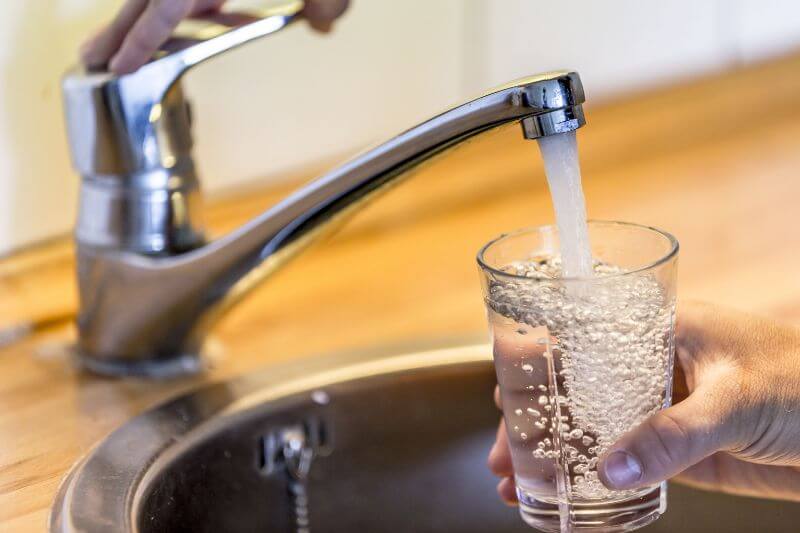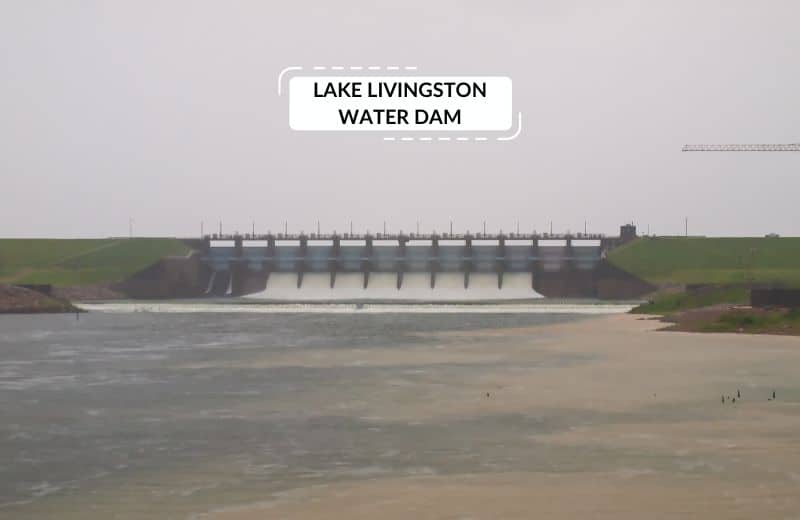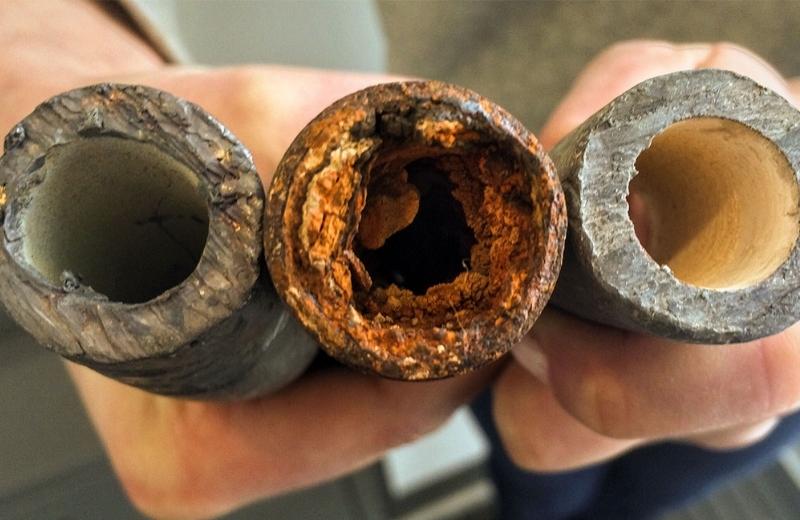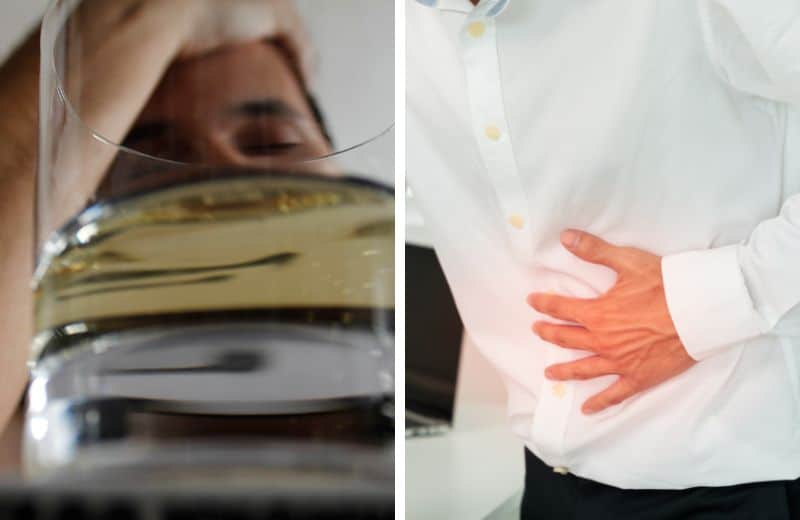Wondering whether or not Houston water is safe to drink? How does Houston’s tap water compare to water in other parts of the country? And are there any contaminants found above guidelines in Houston’s drinking water? We’ve answered all these questions and more in this guide.
📌 Key Takeaways
- Houston tap water is considered generally safe to drink.
- Houston has complied with health-based drinking water standards in the past couple of years
- The City has minor problems with lead, chloramine, haloacetic acids and total trihalomethanes (TTHMs)
Table of Contents
- 🚰 Can You Drink Houston Tap Water?
- 🗺️ Where Does the Tap Water in Houston Come From?
- 📉 Who Regulated Houston Drinking Water?
- 📋 Houston Water Quality Report
- ☣️ Contaminants Found Above Guidelines in Tap Water in Houston
- 🧫 Main Contaminants Found in Houston Tap Water
- ⛲ Houston Drinking Water in Public Places
- 💬 Frequently Asked Questions
🚰 Can You Drink Houston Tap Water?
Yes, you can drink tap water in Houston, and the water is considered clean and safe according to federal and state standards.
Houston’s drinking water typically contains contaminants at lower levels than the MCLs(Maximum Contaminant Levels) set by the Environmental Protection Agency (EPA).
💡 With that said, there are some contaminants found in Houston tap water that are within the EPA’s guidelines, but exceed the Health Guidelines set by the Environmental Working Group.
The Environmental Working Group is an independent organization that doesn’t have any legal control over the national standards set for drinking water. According to the EWG, many of the EPA’s MCLs are too lenient, and the national limits should be stricter.
So, according to the EPA, tap water in Houston is legally safe to drink. According to the EWG, due to the presence of certain contaminants, it isn’t. More on these contaminants later.

An EPA database from 2019-2022 shows that Houston has only had one violation in early 2019 relating to the Revised Total Coliform Rule. This was a monitoring violation (so it doesn’t necessarily mean that the water became contaminated by coliform) and was marked as “Resolved” by the EPA.
👉 Check out our post for the full lowdown on which states have the worst drinking water.
Houston SDWA Violations Within 10 Years
| Period of Compliance | Resolved? | Health-Based? | Category Code | Code | Rule Code | Contaminant Code | Rule Group Code | Rule Family Code |
|---|---|---|---|---|---|---|---|---|
| 12/01/2019- 12/31/2019 | Yes | No | Monitoring Violation (MON) | Monitoring, Routine (RTCR) (3A) | Revised Total Coliform Rule (111) | Revised Total Coliform Rule (8000) | Microbials (100) | Total Coliform Rules (110) |
| 10/01/2015 | Yes | No | Monitoring and Reporting (MR) | Follow-up or Routine LCR Tap M/R (52) | Lead and Copper Rule (350) | Lead and Copper Rule (5000) | Chemicals (300) | Lead and Copper Rule (350) |
| 05/01/2015- 05/31/2015 | Yes | Yes | Maximum Contaminant Level Violation (MCL) | Maximum Contaminant Level Violation, Monthly (TCR) (22) | Total Coliform Rule (110) | Coliform (TCR) (3100) | Microbials (100) | Total Coliform Rules (110) |
| 04/01/2015- 04/30/2015 | Yes | Yes | Maximum Contaminant Level Violation (MCL) | Maximum Contaminant Level Violation, Monthly (TCR) (22) | Total Coliform Rule (110) | Coliform (TCR) (3100) | Microbials (100) | Total Coliform Rules (110) |
Data Source: EPA ECHO database
🗺️ Where Does the Tap Water in Houston Come From?
Houston’s drinking water comes from various surface water sources around the region, including lakes and rivers.
Most of Houston’s drinking water (86%) comes from Lake Livingston, which is sourced by the Trinity River. Lake Houston and Lake Conroe, sourced by the San Jacinto River, also supply some of the drinking water in several neighborhoods in Houston. The other 14% come from deep underground wells drilled into the Evangeline and Chicot aquifers.
📌 Is there anything to note about Houston’s water being largely surface water, not groundwater? Surface water is more exposed to the elements than groundwater, and is likely to contain more contaminants from air fallout and surface runoff, requiring more extensive treatment to make it safe to drink.

📉 Who Regulated Houston Drinking Water?
The City of Houston drinking water is managed by Water Treatment Operations and regulated by the Environmental Protection Agency.
The EPA regulates Houston’s water treatment plant, and all other water treatment facilities in the US, through quarterly monitoring and water testing.
The EPA has a list of contaminants (find them here) that are regulated according to the National Primary Drinking Water Regulations.
If water treatment facilities exceed the maximum amounts of these contaminants in their water supplies, the EPA can enforce the water systems to remedy the problem. The EPA expects water facilities to show proof that they have amended a detected water quality issue.
📋 Houston Water Quality Report
The most recent Water Quality Report for Houston is dated from January to December 2021.
The report shows that at Houston’s water treatment plant, the majority of contaminants were detected below the highest level allowed.
However, a few contaminants were detected slightly above this level (more on that below).
📌 Plus, it’s important to note that although most contaminants were below the highest level allowed, some were still present in trace amounts – so Houston’s water isn’t 100% healthy.
For instance, the EPA’s MCL for lead is 15 PPB, but the ideal goal for lead is 0 PPB. So, even if Houston’s water contains lead below 15 PPB (which it usually does), that doesn’t mean that the water quality is as good as it could be with 0 PPB of lead.
We recommend taking a look at Houston’s Water Quality Report and deciding whether or not you want to filter your drinking water based on the data available.
| Term | Description |
|---|---|
| Period of Compliance | Time period which a violation took place and resolved. |
| Status | Indication of the most recent compliance status of the violation. Resolved: The system has returned to compliance from the violation Archived: The violation is not yet resolved, but is more than 5 years past its compliance end date. Addressed: The violation is not resolved nor archived, but addressed through formal enforcement. Unaddressed: The violation has not been addressed, resolved, nor archived |
| Health Based | Whether the violation affects health standards. |
| Category Code | Category of violation by which it is reported. TT: Treatment Technique Violation MRDL: Maximum Residual Disinfectant Level Other: Other Violation MCL: Maximum Contaminant Level Violation MR: Monitoring and Reporting MON: Monitoring Violation RPT : Reporting Violation |
| Code | A complete description of violation codes. |
| Contaminant Code | Represents a contaminant for which the municipal water system has incurred a violation against a primary drinking water regulation. |
| Rule Code | The National Drinking Water rule. 110: Total Coliform Rule 121: Surface Water Treatment Rule 122: Long Term 1 Enhanced Surface Water Treatment Rule 123: Long Term 2 Enhanced Surface Water Treatment Rule 130: Filter Backwash Rule 140: Ground Water Rule 210: Stage 1 Disinfectants and Disinfection Byproducts Rule 220: Stage 2 Disinfectants and Disinfection Byproducts Rule 230: Total Trihalomethanes 310: Volatile Organic Chemicals 331: Nitrates 332: Arsenic 333: Inorganic Chemicals 320: Synthetic Organic Chemicals 340: Radionuclides 350: Lead and Copper Rule 410: Public Notice Rule 420: Consumer Confidence Rule 430: Miscellaneous 500: Not Regulated 111: Revised Total Coliform Rule |
| Rule Group Code | Uniquely defines a rule group. 120: Surface Water Treatment Rules 130: Filter Backwash Rule 140: Groundwater Rule 210: Stage 1 Disinfectants and Disinfection Byproducts Rule 220: Stage 2 Disinfectants and Disinfection Byproducts Rule 230: Total Trihalomethanes 310: Volatile Organic Chemicals 320: Synthetic Organic Chemicals 330: Inorganic Chemicals 340: Radionuclides 350: Lead and Copper Rule 400: Other 500: Not Regulated 110: Total Coliform Rules 410: Public Notice Rule 420: Consumer Confidence Rule 430: Miscellaneous |
| Rule Family Code | Defines the rule family code. 100: Microbials 200: Disinfectants and Disinfection Byproducts Rule 300: Chemicals 400: Other 500: Not Regulated |
☣️ Contaminants Found Above Guidelines in Tap Water in Houston
There are several different water systems supplying Houston’s water. Here, we’ll just be looking at the water quality of the Main System (or this guide would go on forever).
If you get your water from the Kingwood System, the Willow Chase System, the District 73 System, the District 82 System, or the Belleau Wood System, you can find data for these systems by scrolling down on the Water Quality Report.
According to Houston’s Water Quality Report, in the Main System, the following contaminants were detected in levels above EPA drinking water guidelines in 2021:
Chloramine
Chloramine, used as a disinfectant in Houston water, was detected slightly over the EPA’s highest level allowed in tap water. 4.65 PPM (parts per million) of chloramine was detected, versus the EPA’s highest allowed number: 4.0 PPM.
Lead
The EPA’s maximum allowed level for lead is 15 PPB (parts per billion). Lead is a dangerous toxicant since it builds up in the body over time, leading to serious health effects. Three samples of lead were detected above the EPA’s maximum allowed level, while 90% of samples were below 3.4 PPB.

Haloacetic Acids
While some tests didn’t detect haloacetic acids at all in Houston’s water, others detected this contaminant up to 34 PPB – 7 PPB higher than the EPA’s highest allowed. This is unsurprising given that haloacetic acids are a disinfection byproduct and high levels of chloramine are detected in Houston’s water.
Total Trihalomethanes
Total trihalomethanes (TTHMs), another disinfection byproduct, were also detected in varying levels in different water tests. Some tests didn’t detect total trihalomethanes at all, while others detected up to 52 PPB of this contaminant – 14 PPB higher than the highest allowed.
All other contaminants in Houston’s drinking water supply, including arsenic, fluoride, and uranium, were all detected at “safe” levels. But how safe is it?
The EPA’s highest allowed level of arsenic is 10 PPB, and 5.3 PPB of arsenic was detected in the Main System. For cyanide, the EPA’s highest allowed level is 200 PPB, and the Main System’s water contained 140 PPB of this contaminant. The EPA’s highest allowed for combined radium is 5 pCi/L, and the Main System’s water contained 2.5 pCi/L of this contaminant.
💡 What does this mean? Houston’s tap water is safe by EPA standards, but it isn’t entirely contaminant-free. Most of us would prefer to drink no arsenic, cyanide, or radium whatsoever, given the choice.
| Utility details | Contaminants Exceeding Guidelines | Other Contaminants Detected |
|---|---|---|
| Data available: Dec 2021 Source: Surface water | Chloramine Lead Haloacetic Acids Total Trihalomethanes | Aluminum Arsenic Atrazine Barium Bromide Chloride Chloroform Combined Radium Combined Uranium Copper Cyanide Di(2-ethylhexyl)phthalate Disinfection byproducts Ethylbenzene Fluoride Germanium Hexavalent chromium Iron Manganese Nitrate O-Toluidine pH Radiological contaminants Selenium Simazine Sulfate Toluene Turbidity Xylenes Zinc |
🧫 Main Contaminants Found in Houston Tap Water
Now we’ve looked at the contaminants present above the MCL in Houston’s drinking water, let’s look at the contaminants you’re generally most likely to find in your Houston water supply:
- Arsenic – one of the most dangerous contaminants of all, arsenic is cancer-causing and highly toxic to humans.
- Chloroform – although low levels of chloroform aren’t considered harmful to health, elevated levels of this contaminant may damage the kidneys or liver.
- Chloramine – this is the most common disinfectant used to make Houston tap water safe to drink. Chloramine isn’t considered dangerous in the EPA’s allowed levels.
- Disinfection byproducts – the likes of bromodichloromethane, dichloroacetic acid, and trihalomethanes are all produced as byproducts of disinfection, and have numerous health effects, including cancer and fertility problems.
- Hexavalent chromium – this carcinogen is difficult to remove with standard filtration methods, and usually requires a thorough filtration process, like reverse osmosis.
- Lead – this dangerous metal usually leaches into water from lead pipes. Many old pipes in Houston are made from lead.
- Radiological contaminants – these naturally occurring contaminants are known to cause cancer even when present in low levels

⛲ Houston Drinking Water in Public Places
We know about the quality of the local tap water in Houston, but what about the water in public places, like hotels, bars, and restaurants?
All restaurants in Houston are legally required to provide free tap water. This is the same water that’s supplied to homes in the City. Sometimes a restaurant may offer filtered tap water free of charge.
Hotels should also supply drinking water in their rooms. If water isn’t safe for drinking, there should be a sign letting you know, and the hotel’s bar or reception should be able to provide drinkable tap water.
If you’d rather not drink tap water, you can find bottled water in all grocery stores in Houston. Popular bottled water brands sold in the city are Dasani, Fiji, Aquafina, and Smartwater.
💬 Frequently Asked Questions
Is Houston tap water safe to drink?
Yes, Houston tap water is safe to drink. According to Houston’s most recent water quality report, most contaminants were detected at levels below the EPA’s maximum allowed levels. A few contaminants, like chloramine and a couple of disinfection byproducts, were detected at slightly higher levels in some tests. Your Houston tap water may contain lead, depending on the age and quality of the water supply lines in your neighborhood. Test your water if you’re concerned.
Can you drink Houston tap water 2022?
Yes, you can drink Houston water in 2022. Houston’s water quality is good, and the Houston treatment plant disinfects water to kill microorganisms that could make you sick. The only time you shouldn’t drink Houston water is if a boil water notice is issued. This tells you that a potential risk has been detected in the tap water, and you should drink bottled water or boil your water until the notice is lifted.
Is the water in Houston contaminated?
The tap water in Houston is considered safe and not contaminated. However, the Environmental Working Group believes that the EPA’s standards are too lenient and sets its own guidelines for contaminants in drinking water. According to the EWG, Houston drinking water contains arsenic, hexavalent chromium, radium, uranium, and disinfection byproducts in levels that are higher than safe for drinking.
How do Texans get clean drinking water?
Local water supplies in the City of Houston are filtered and disinfected (with chloramine or chlorine treatment) before they’re delivered to homes. This gives Texans access to clean drinking water. Houston has a superior water system and drinking tap water in Houston should always be safe except for in the case of an emergency.
Is there lead in Houston water?
According to the 2019-2200 EPA ECHO Database, 90% of samples from Houston’s water supply contained lead levels of 0.00401 mg/L or below. This is about a quarter of the EPA’s action level for lead. 10% of samples were above this level.
However, keep in mind that this water testing refers to the lead levels in Houston water at the treatment plant. Many of Houston’s old water supply pipes still contain lead, which leaches into water as it travels to neighborhoods. Old buildings are also known to have lead service lines and pipes.
Lead is considered dangerous in any amount, so it’s important to test your water if you’re concerned about lead exposure. Check out this article to learn more about Houston’s lead problem and work out whether or not your neighborhood is likely to be affected by lead contamination.
Is the tap water in Houston fluoridated?
Yes, Houston’s water has been fluoridated since a council vote in 2002. Fluoride offers dental health benefits, but it’s also known to have some health effects when consumed in excess, including dental and skeletal fluoridation.
Why does Houston’s tap water smell?
You may notice an earthy, mineral-y, or fishy odor in Houston’s tap water. This is caused by a number of factors, including chlorine buildup and natural matter in the water source, like algae. Your water should be safe to drink, despite the smell, unless a boil water notice is issued.
Do you need to boil Houston water?
No. You don’t need to boil Houston water unless a boil water notice is issued. Boiling water does only two things: kills microbiological contaminants and encourages chlorine to dissipate at a faster rate. Since Houston water is microbiologically safe and is disinfected with chloramine (which takes much longer to dissipate than chlorine), boiling water in this region will make little difference to quality.

